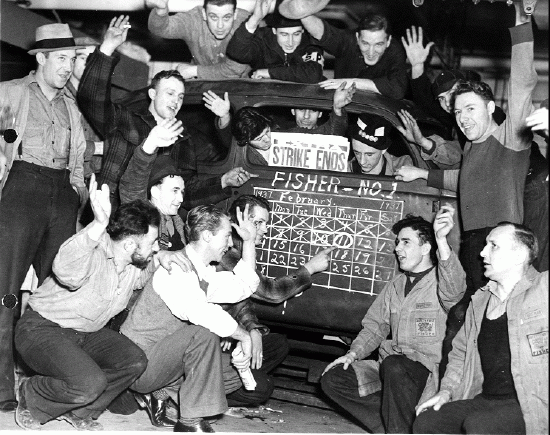Once They Started, Sit-Downs Spread Like Wildfire

Since workers at Republic Windows and Doors in Chicago occupied their factory last December—and won—many people have been trying to remember the big wave of sit-downs that swept through the U.S. during the Great Depression. Could there be a similar wave today?
We’ll soon see (for more on that, see page 7). After the big General Motors sit-down strike of 1936-37, it took a bit for the UAW’s victory to sink in. Once it did, sit-downs spread like wildfire.
A sit-down strike offered many advantages over a conventional strike. Scabs couldn’t take over the jobs of strikers, because the strikers were still there, right in the workplace. Employers were less likely to send in the police, because they’d risk damaging their own property. Even more importantly, if they did drag people out, they’d produce nasty publicity against the company.
Meanwhile, camped out inside their workplace, strikers were squished in together, at risk, and developed a wonderful sense of camaraderie—precisely the feeling of solidarity that a labor movement is all about.
QUICKIES
Workers in the U.S. started experimenting with “quickie” sit-downs in 1936, mostly in meatpacking and auto-parts factories. They’d just sit down and refuse to work, and within a few hours win modest demands. More than 35,000 workers occupied their workplaces that year, in 70 different strikes.
They got the idea from a massive wave of sit-downs that swept Europe in the mid-’30s. Almost one-fifth of all wage-earners in French stores and factories staged sit-downs in May and June 1936 alone.
U.S. workers’ biggest sit-down strike was at General Motors, where workers seized a key plant in Flint, Michigan, in December 1936.
After a six-week occupation that riveted the nation, the workers won an enormous victory: GM capitulated completely and agreed to negotiate a national contract with the brand-new United Auto Workers union.
The nation was stunned. The UAW was a new little pipsqueak union, and it had beaten GM, the world’s biggest corporation. The effect on working people was exhilarating.
For a few days people absorbed the news. Then an enormous wave of small, short sit-downs erupted. The biggest number was in Detroit, where working people had been closely connected to the giant GM strike. Three hundred women and a few men at the Ferry-Morse Seed Company staged a sit-down. Sixty high school boys who delivered lunches to factories sat down and won a 25 percent pay raise in five hours. That same night 55 women who cleaned a glamorous downtown building won a pay raise in a two-hour occupation.
These sit-downs weren’t just in factories—they were in all kinds of workplaces, including offices, laundries, and transportation. The strikers were both women and men.

SUPPORT LABOR NOTES
BECOME A MONTHLY DONOR
Give $10 a month or more and get our "Fight the Boss, Build the Union" T-shirt.
After the GM strike, employers were running scared. Public opinion was on the side of the strikers, and elected officials evidently weren’t going to send in the police.
Two weeks after the UAW’s victory, a hundred young women at the big Woolworth’s department store in downtown Detroit surprised the country with their own famous strike. They occupied the store, but Woolworth’s, a huge chain with 2,769 stores in five countries, wasn’t about to give in to another “quickie” strike. The women spent a nerve-wracking week in the store, the focus of massive publicity (even Life magazine turned up). On day seven they won all their demands, including a 20 percent wage increase, union recognition, free laundering of uniforms, and astonishingly, 50 percent pay for work hours during the occupation.
The Woolworth strikers’ agreement, moreover, covered employees at all 40 Detroit-area stores. Within a few months, chain stores throughout the country were capitulating to workers’ demands.
CRACK-DOWN
By May 1937, though, employers and their allies in the government had begun to crack down. Mayors, governors, and, eventually Congress turned against the sit-downs and started arresting and evicting strikers. The window of opportunity swiftly closed.
Will the Republic Windows sit-down open our own moment of opportunity and spark a new wave? Public opinion, including the Chicago city government, President-elect Obama, and the national news media, were all on the Republic Workers’ side, lined up, for once, against the greedy bankers of our own time.
Today, corporate power is more global and more consolidated. But the basic situation hasn’t changed: employers still need workers, working people are still outraged by elite profits, and we can still seize the high ground of public opinion with dramatic actions—as the Republic workers proved.
Workers have a big toolbox of tactics they haven’t begun to try out, and plenty to learn from allies abroad. Mexican and Argentinean workers have been occupying factories for years now. Former Ford workers in Ireland just spent a month in a victorious sit-down. And since May 22, auto workers in South Korea have occupied their plant .
Their actions are defensive thus far, aimed at winning better severance packages. But the lesson that comes across—that taking action is better than not—could stir no small change.
“We can win broad support for bold action,” says Mark Meinster, one of the organizers at Republic Windows. “This is a moment we have to seize.”
[Dana Frank is a history professor at University of California, Santa Cruz; she is co-director of the school’s Center for Labor Studies.]





